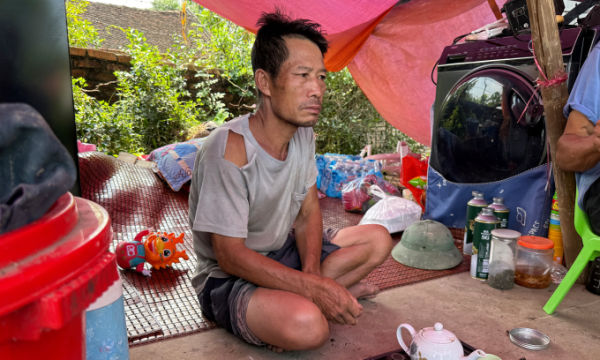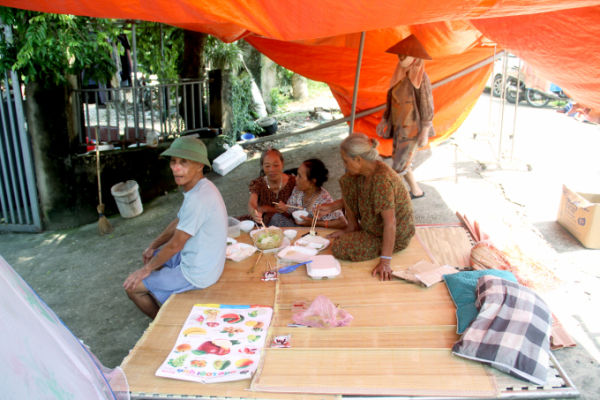
On Sunday noon a heatwave blazed across the dyke. Under an 8-square-meter tarp propped up as a roof, 57-year-old Bui Van Tuan watches a pot of braised fish boil on a gas stove on the grass.
He says: “I caught a fish in the floodwaters. We will have it for lunch before going home to clean up when the water recedes.”
Tuan’s family was one of the first in Mai Hamlet, Trung Gia Commune, to relocate as the floods hit.
When they were informed on the night of Oct. 7 that floodwaters from the Cau River were approaching, he and his wife joined dozens of neighbors to move three refrigerators, two washing machines, 50 sacks of rice, and their buffaloes, cows, chickens, and ducks up the dyke, some 100 meters from their houses.
|
Bui Van Tuan takes shelter with all his belongings on Do Tan Dyke in Trung Gia Commune, Hanoi, at noon on Oct. 12, 2025. Photo by Read/ Thuy Quynh |
On the afternoon of Oct. 8 water overflowed the dyke and flooded Do Tan village.
Village head Nguyen Van Giang said all 856 households were affected, with 185 in Mai Hamlet hit hardest as it is low-lying and close to the dyke.
The hamlet turned into a large lake in which single-story ones were completely submerged and only the rooftops of two-story houses were visible. The two-kilometer dyke became a shelter for the villagers.
Without electricity or clean water, they shared flashlights and used a single generator. The men stayed on the dyke to guard their belongings and livestock, while women, children and seniors took refuge in tall houses in the village.
“Living on the dyke means no flooding but there are other problems,” Tuan says, showing his hands covered in red insect bites. “Mosquitoes and centipedes as big as a toe are everywhere. Someone almost got bitten by a cobra.”
Villagers take turns watching over their belongings through the night. During the day the heat radiating from the concrete surface of the dyke makes the tents unbearably hot. Food spoiled in unpowered refrigerators while clean water has run out. “I have not taken a shower in five days,” Tuan says.
As the water receded and revealed the village road, people made rafts from banana trunks to reach unsubmerged houses in the village and fetch water for cooking and cleaning. “Our legs were bleeding from leech bites after each trip back to the village,” Tuan says.
 |
|
Chung and Thom eat charity meals under a tarpaulin on Do Tan Dyke in Trung Gia Commune, Hanoi. Photo by Read/ Phan Duong |
A few meters away in her tent Luu Thi Chung, 72, opens a charity meal box and eats. She says: “It has been two days since we last had rice and clean water. I have never experienced such hardship in my life.”
Before the flood, Chung and other Do Tan villagers spent days reinforcing the dyke and raising it a meter higher than last year. But by the evening of Oct. 8, the section near Mai Hamlet could not withstand the water and was overwhelmed.
“My house is at the end of the hamlet where water poured in from both sides,” Chung says.
Holding her three-year-old grandchild in one arm and two older ones by the other hand, she ran through the pouring rain. Lightning struck a nearby utility pole, sending sparks and frightening the children.
Behind her, livestock was swept away by the floodwaters.
Villagers ran toward the dyke in panic and shouted above the roar of the water. After running nearly two kilometers to safety, she left her three grandchildren under a tarp with other families before trying to go back to save the animals. “The kids clung to my legs to stop me from going. People stopped me, saying, ‘If you go back now, you will die’.”
Her cousin later rescued two pigs from the flood and brought them to her. That night Chung and her grandchildren huddled with dozens of others under a thin tarp, their clothes soaked.
Bui Thi Thom, 70, went through a similar situation. She said when the dyke broke, she ran home to grab her land certificate and herded her cow and three pigs to safety on the dyke.
In the following days she lived on charity food, sometimes sharing instant noodles with neighbors.
She endured heat during the day and rain at night. “It was a miserable situation,” she says. “But if you are still alive, you have to keep going.”
Villagers set up tents along Do Tan Dyke in Trung Gia Commune, Hanoi, to escape the flooding at noon on Oct. 12, 2025. Video by Read/Thuy Quynh
Around 2,000 houses in nine communes in the capital are still under water. Trung Gia and Da Phuc communes along the Cau and Cong rivers have been hit the hardest. By Sunday noon the water had receded in some areas, allowing people to return home to clean up and bring back their belongings and livestock.
But in a tent at the end of the dyke, Do Thi Hao, 54, says she might have to stay there for a few more days.
“My house is in the lowest area in the hamlet, and the floodwaters are still up to the roof. My sow, my most valuable possession, may not survive.” Chung’s house has resurfaced from under the water, but with its roof bent and damaged. She says she does not know when she can return home, but even if she does the house may no longer be livable.
She has sent her three grandchildren to stay with relatives who have electricity, while she and Thom stayed on the dyke to take care of their pigs and cows. “I am staying here so I can take the food being provided to the children.”
As evening sets in Chung takes medicine for her cold and lies down on a wooden plank to rest. Thom walks along the dyke to check on her livestock. The rice fields that were ready for harvest are now inundated and possibly destroyed.
“We are out of rice and grass. People don’t have enough to eat, so there is nothing left to feed the pigs and cows. I will probably have to sell them.”